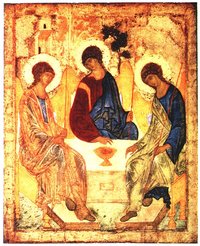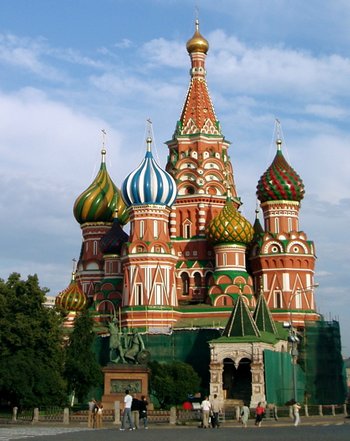Culture of Russia
|
|
Russian culture began around the 10th century B.C. with the development of East Slavic culture. Modern Russian Culture is highly complex and has changed under Czarist and Soviet rules and under the relgious leadership of the Russian Orthodox Church.
| Contents |
History of Russian Culture
Main article: History of Russian Culture
Art
Icon painting
Russian icon painting was inherited from the Byzantine churches. It became an offshooot version of the mosaic and fresco traditions. Icon paintings in Russia are unique because they are made to help people with prayers instead of idolizing the figure in the paiting. The most comprehensive collection of Icon art is found at the Tretyakov Gallery.[1] (http://www.geographia.com/russia/rusart01.htm)
Russian avant garde
Main article: Russian avant garde
Artwork_by_El_Lissitzky_1919.jpg
An example of Russian avant garde art by El Lissitzky in 1919
The Russian avant garde is an umbrella term used to define the large, influential wave of modernist art that flourished in Russia from approximately 1890 to 1930 - although some place its beginning as early as 1850 and its end as late as 1960. The term covers many separate, but inextricably related, art movements that occurred at the time; namely neo-primitivism, suprematism, constructivism, and futurism. Notable artists from this era include El Lissitzky, Kazimir Malevich, Wassily Kandinsky, Vladimir Tatlin, Alexander Rodchenko, and Marc Chagall amongst others.
Soviet Art
Main article: Soviet Art
During the Russian Revolution a movement was initiated to put all arts to service of the dictatorship of the proletariat. The instrument for this was created just days before the October Revolution, known as Proletkult, an abbreviation for "Proletarskie kulturno-prosvetitelnye organizatsii" (Proletarian Cultural an Enlightenment Organizations). A prominent theorist of this movement was Aleksandr Bogdanov. Initially Narkompros (ministry of education), which was also in charge of the arts, supported Proletkult. However the latter sought too much independence from the ruling Communist Party of Bolsheviks, gained negative attitude of Vladimir Lenin, by 1922 declined considerably, and was eventually disbanded in 1932. After Stalin died Soviet Art went into decline after Stalin's death as gradually Russians artists became more independent of the state and in the 1980's the government ruled that it could not restrict what Russians artists could paint.
Architecture
Russian architecture has been mostly influenced by the Russian Orthodox relgion pre-World War I, Soviet culture until 1990 and since then western influences. One of Russia's most notable types of architecture, churches took its style around the 11th century. Foreign architecutre didn't begin to influence Russia until the Assumption Cathedrals, which was completed by the Bolognese architect Aristotle Fioravanti. European architecture was firmly established in Russian under Czar Catherine. During the 1700's and 1800's the Naryshkin baroque,with many similarties to European baroque style, was popular. Througout the majority of the 1900's russian architeture was dominated by the Stalinist style. [2] (http://www.geographia.com/russia/rusart01.htm)
Some notable Russian buildings include:
- Cathedral of the Assumption, Smolensk
- Cathedral of Christ the Saviour (Moscow)
- Cathedral of Christ the Saviour (Kaliningrad)
- Cathedral of the Annunciation
- Cathedral of the Archangel
- Cathedral of the Dormition
- Church of the Savior on Blood
- Elokhovo Cathedral
- Saint Basil's Cathedral
- Saint Isaac's Cathedral
- Kolomenskoye
- Catherine Palace
- Grand Kremlin Palace
- Winter Palace
- Simonov Monastery
- Novospassky Monastery
- Moscow State University
- Ostankino Tower
- Triumph-Palace, a modern skyscraper
- White House of Russia
Cinema
Main article: Cinema of Russia and Soviet Union
While Russia was involved in filmmaking as early as most of the other nations in the West, it only came into prominence during the 1920s when it explored editing as the primary mode of cinematic expression. Because of the depletion of resources due to World War I, Russian film schools would take copies of D. W. Griffith's Intolerance and re-cut it as an exercise in creating meaning.
"Soviet Cinema" should not be used as a synonym for "Russian Cinema". Although Russian language films predominated, several republics developed lively and unique cinemas, while others did not. Most notable for their republican cinema were Georgia, Lithuania, Ukraine, and, to a lesser degree, Belarus and Moldova.
Dance
- Main articles: Barynya - Kamarinskaya
Music of Russia
Main article: Music of Russia
Russia is a large and extremely culturally diverse country, with dozens of ethnic groups, each with their own forms of folk music. During the period of Soviet domination, music was highly scrutinized and kept within certain boundaries of content and innovation. After the fall of the USSR, western-style rock and pop music became the most popular musical forms in Russia. Some native artists broke through.
Opera
Dadon_shemakha.jpg
The first known opera made in Russia was "A Life for the Tsar" by Mikhail Glinka in 1836. This was followed by sevearal opears like "Ruslan and Lyudmila" in 1842 and "Kamarinskaya" in 1848. Russsian opera was originally a combination of Russian folk music and Italian opera. After the October revolution many opera composers left Russia. Russia's most popular operas include:
Matryoshka doll and other handicraft
Main article: Matryoshka doll
A Matryoshka doll (Cyrillic матрёшка or матрешка) is a Russian nesting doll. A set of
Matreshka.jpg
Matryoshka dolls consists of a wooden figure which can be pulled apart to reveal another figure of the same sort inside. It has in turn another figure inside, and so on. The number of nested figures is usually six or more. The shape is mostly cylindrical, rounded at the top for the head and tapered towards the bottom, but little else; the dolls have no hands (except those that are painted). The artistry is in the painting of each doll, which can be extremely elaborate. The theme is usually peasant girls in traditional dress, but can be almost anything, for instance fairy tales or Soviet leaders.
Other forms of Russian handicraft inlcude:
Other art related subjects of interest
Language
Russian is the common official language throughout the Russian Federation understood by 99% of its current inhabitants and widespread in many adjacent areas of Asia and Eastern Europe. National subdivisions of Russia have additional official languages For information on individual languages and Russian dialects see:
- Languages of Russia (http://en.wikipedia.org/wiki/Category:Languages_of_Russia)
Literature
Main article: Russian Literature
Russian literature refers to the literature of Russia or its �migr�s, and to the Russian-language literature of several independent nations once a part of what was historically Russia or the Soviet Union. With the break up of the USSR different countries and cultures may lay claim to various ex-Soviet writers who wrote in Russian on the basis of birth or of ethnic or cultural associations.
Formalism
Main article: Russian Formalism
Russian Formalism refers to a number of highly influential Russian and Soviet scholars (Viktor Shklovsky, Yuri Tynianov, Boris Eichenbaum, Roman Jakobson, Grigory Vinokur) who revolutionised literary criticism between 1914 and the 1930s by establishing the specificity and autonomy of poetic language and literature. Russian Formalism exerted a major influence on thinkers such as Mikhail Bakhtin and Yuri Lotman, and on structuralism as a whole. The movement's members are widely considered as the founders of modern literary criticism.
Poetry
Bilibin3_saltan.jpg
Acmeist poetry-Bogatyr-Bylina-Onegin stanza
Famous poems:
Cuisine
Pierogi.jpg
Main article: Russian cuisine
Russia has a rich history and offers a wide variety of soups, dishes made from fish, cereal based products and drinks. Vegetables, fruit, mushrooms, berries, herbs also play a major part while meat does not. Primordial Russian products such as caviar, smetana, buckwheat, rye flour, etc. have had a great influence on world cuisine.
Martial Arts
Main article: Russian martial arts
Russia has an extensive history of martial arts. Some of its most well known forms include the Kadochnikov's Systema, Retuinskih's System ROSS, Ryabko's Systema, Sambo, and Systema.
Media
Russian media began largely under the Soviet Union. However during this period all media was controlled by the government and many of the freedoms Western newspapers are used to were denied. At this time Russia's most famous newspaper was Pravda. It was an official publication of the Communist Party between 1918 and 1991. The paper is still in operation in Russia, but it is most famous in Western countries for its pronouncements during the period of the Cold War. A number of other, less famous, newspapers were (and are) also called Pravda. Russian media has grown extensively since its suppression during the Communist period. The largest newspaper in Russia currently is Trud, followed by the Russian Pravda. The first English language newspaper in Russia was the Moscow News.
Religion
Philaret.jpg
Ethnic Russians has been predominately Russian Orthodox. However during the Soviet control Atheism was favored by the government which lead to some decline in the Orthodox church. Other minority ethnic groups of Russia often hold to Islam and Animism. Judaism also a large presence and Catholicism, Protestantism, and Buddhism. Related Articles:
- Church of the last testament
- History of the Jews in Russia and the Soviet Union
- Islam in Russia
- Law on Freedom of Conscience and Religious Associations
- Old believers
- Religion in the Soviet Union
- Russian Orthodox Church
- Russian Catholic Church
Tourism
Main article: Tourism in Russia
Yuri_Vladivostok_20030804_118.jpg
Russia is not the typical country for westerners to go to during their vacations though it has much to offer: Russia has rich cultural heritage, embodied in the cities of Moscow with Tretyakov Gallery, Bolshoi Theatre or the Kremlin's collections, and Saint Petersburg on river Neva, close to the Baltic Sea, with its famous "white nights", the art collections of the Hermitage Museum and the Russian Museum.
In the countryside there are many little towns with old cloisters and castles. There are cities with an own rich tradition like Kaliningrad (formerly K�nigsberg) on the Baltic Sea coast, Novgorod on Lake Ilmen, Tver, Vologda, Nizhni Novgorod, Kirov, Ekaterinburg or Rostov.
Famous for tourists are trips on the big rivers like Volga, Lena or Yenisei as well as trips on the famous Trans-Siberian railway to Vladivostok on the Pacific Ocean. Russia is not only cold: The coasts of Black Sea and Caspian Sea offer a climate like the Mediterranean Sea. A famous city for vacations on the beach is Sochi.
Humor
Main article: Russian humour
Russia gains much of its wit from the great flexibility and richness of the Russian language, allowing for plays on words and unexpected associations. Like with any other nation, its vast scope ranges from lewd jokes and silly wordplay to political satire.
Anecdote
Main article: Russian jokes
Russian jokes are , the most popular form of Russian humour, are short fictional stories or dialogues with a punch line. Russian joke culture features a series of categories with fixed and highly familiar settings and characters. Surprising effects are achieved by an endless variety of plots. Russians love jokes on topics found everywhere in the world, be it sex, politics, spouse relations, or mothers-in-law. This article discusses Russian joke subjects that are peculiar to Russian or Soviet culture.
Chastushka
Main article: Chastushka
Chastushka, is a type of traditional Russian poetry, is a single quatrain in trochaic tetrameter with an abab or abcb rhyme scheme. Usually humorous, satirical, or ironic in nature, chastushkas are often put to music as well, usually with balalaika or accordion accompaniment. The rigid, short structure (and, to a lesser degree, the type of humor these use) parallels limericks in British culture. The name originates from the Russian word части́ть, to speak fast.


